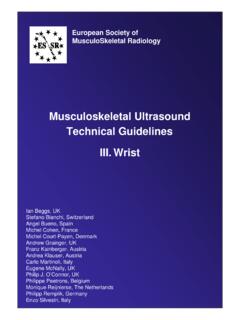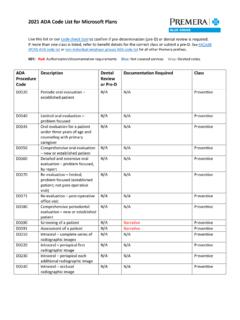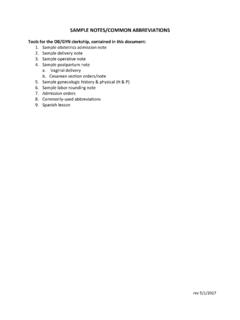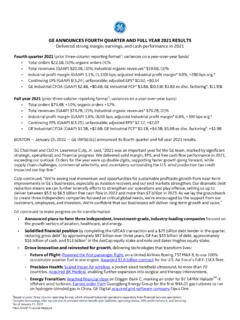Transcription of Musculoskeletal Ultrasound Technical Guidelines VI
1 European Society of Musculoskeletal RadiologyMusculoskeletal UltrasoundTechnical GuidelinesVI. AnkleIan Beggs, UKStefano Bianchi, SwitzerlandAngel Bueno, SpainMichel Cohen, FranceMichel Court-Payen, DenmarkAndrew Grainger, UKFranz Kainberger, AustriaAndrea Klauser, AustriaCarlo Martinoli, Italy Eugene McNally, UKPhilip J. O Connor, UKPhilippe Peetrons, BelgiumMonique Reijnierse, The NetherlandsPhilipp Remplik, GermanyEnzo Silvestri, ItalyThe systematic scanning technique described below is only theoretical, considering the fact that the examination of the ankle is, for the most, focused to one (or a few) aspect(s) only of the joint based on clinical seated on the examination bed with the knee flexed 45 so that the plantar surface of the foot lies flat on the table. Alternatively, the patient may lie supine with the foot free to allow manipulation by the examiner during scanning. Place the transducer in the axial plane and sweep it up and down over the dorsum of the ankle to examinethe tibialis anterior, extensor hallucis longus and extensor digitorum longus.
2 These tendons must be examined in their full length starting from the myotendinous junction. Look at the tibialis anterior artery and the adjacent deep peroneal : a, anterior tibial ar-tery; edl, extensor digitorum longus tendon; ehl, exten-sor hallucis longus tendon; ta, tibialis anterior tendon; void arrows, distal tibialis anterior tendon; v, anterior tibial vein; void arrowheads, superior extensor retinacu-lum; white arrowhead, deep peroneal nerve1 AnkleBe sure to examine the superior extensor retinaculum and the insertion of the tibialis ante-rior tendon, which lies distally and medially. Follow the tibialis anterior tendon up to reach its insertion onto the first cuneiform. Cuneiform1taedlehlTalusehlav 2 Place the transducer in the mid longitudinal plane over the dorsum of the ankle to examine the anterior re-cess of the tibiotalar joint. Fluid may be shifted away from this recess using ex-cessive plantar flexion.
3 60%-70% of the talar dome can be easily assessed by moving the probe medially and : asterisks, anterior fat pad; arrows, anterior recess of the tibiotalar joint; T, tibia; TD, talar dome; TH, talar head2 Ankle3 From the position described at point-1, roll the forefoot slightly internally (inversion) to stretch the lateral ligaments. A small pillow under the medial malleolus may help to impro-ve the contact between transducer and skin over the lateral ankle. Place the transducer parallel to the examination bed placing its posterior edge over the distal lateral malleolus to image the anterior talofibular ligament. Legend: Anterior drawer test in patient with anterior talofibular ligament tear. asterisks, ligament stumps; arrow, talar shift; 1, talar landmark; 2, fibular landmarkTTalusTH**LMTalusWhen distinguishing a partial from a complete tear is difficult, perform a so-nographic anterior drawer test by pla-cing the patient prone with the foot hanging over the edge of the exami-nation table while pulling the forefoot anteriorly when in plantar flexion and inversion.
4 When the ligament is torn, the anterior shift of the talus against the tibia will open the gap in the sub-stance of the ligament. **1221 ! TDLegend: LM, lateral malleolus; void arrowheads, anterior talofibular ligament4 From the position described at point-3 (first sentence), keep the posterior edge of the transducer on the lateral malleolus and rotate its anterior edge upwards to image the anterior tibiofibular ligament. The transducer will pass over a part of the talar cartilage, which lies in between the anterior talofibular ligament and the anterior tibiofibular : arrowheads, anterior tibiofibular ligament; LM, lateral malleolus5 With the ankle lying on its medial aspect, place the transducer in an oblique coronal plane with its superior edge over the tip of the lateral malleolus and its inferior margin slightly posterior to it, towards the heel, while the foot is dorsiflexed to image the calcaneofibularligament.
5 Legend: arrowheads, calcaneofibular ligament; LM, lateral malleolus; pb, peroneus brevis tendon; pl, peroneus longus tendonCalcaneus LMplpbplpbCalcaneus LM ! ! 6 Look at the following midtarsal ligaments: dorsal talonavicular, dorsal calcaneocuboid and calca-neo-cuboido-navicular ligament (avulsion of the anterolateral tu-bercle of the calcaneus).4 AnkleLegend: arrowheads, dorsal talonavi-cular ligament; NAV, navicular boneNAVT alus7 Behind the lateral malleolus, place the transducer over the peroneal tendons to examine them in their short-axis (long-axis planes are of limited utility). Because these tendons arc around the malleolus, tilt the transducer to maintain the US beam perpendicular to them and avoid anisotropy as scanning progresses. Continue to follow these tendons upwards for approximately 5 cm and downwards through the inframalleolar region. LMLM pbmpbmCheck them at the level of the peroneal tubercle of calcaneus, and the peroneus longus down to the area where the os peroneum can be found.
6 Follow the peroneus brevis until the base of the 5th metatarsal. Look at the superior and inferior peroneal retinacula. Legend: arrowheads, peroneus brevis tendon; curved arrows, superior extensor retinaculum; LM, lateral malleolus; pbm, peroneus brevis muscle; void arrow, peroneal tubercle; white arrow, peroneus longus tendonWhen intermittent subluxation of the peroneals is suspected clinically, perform scanning at rest and during dorsiflexion and eversion of the foot against resistance, placing the transducer in a transverse plane over them, at the level of the lateral malleolus. Stress eversion can be done while pushing with the examiner s free hand on the forefoot of the patient, to see subtle subluxation or distension of the superior retinaculum. ! ! " 8 For examination of the medial ankle, the patient is seated with the plantar surface of the foot rolled internally or in a frog-leg position.
7 Alternatively, the patient may lie supine with the foot rotated slightly laterally. A small pillow under the lateral malleo-lus may help to improve the contact between transducer and skin over the medial ankle. The examination of tendons is per-formed : a, tibialis posterior artery; MM, medial malleolus; v, posterior tibial veins; void arrowheads, flexor digitorum longus tendon; white arrowheads, flexor retinaculum; white arrows, tibialis posterior tendon Behind the medial malleolus, place the transducer over the short-axis of the tibialis posterior and the flexor digitorum longus tendons. Follow the tibialis posterior from the myotendin-ous junction down to its insertion on short-axis planes. Check the presen-ce of an accessory navicular bone on long-axis scans over the insertion of the tibialis posterior. ###$$9 Examine the flexor digitorum longus tendon down to reach the sustentaculum tali.
8 Look at the flexor retinaculum, the posterior tibial vessels and the tibial nerve with its divisional branches (medial and lateral plantar nerves). Compression may help to assess whether the veins are : AbdH, abductor hallucis muscle; curved arrow, tibial nerve; fhl, flexor hallucis longus tendon; ST, sustentaculum tali; straight arrows, flexor digitorum longus tendon; void arrowhead, posterior tibial artery; white arrowheads, posteiror tibial veins% % &$ " ! # 10In the same position, look more posteriorly to demonstrate the flexor hallucis longus. Bony landmarks are the lateral and medial talar tuber-cles. The tendon lies in between them. Use pas-sive flexion-extension of the great toe to assess this tendon while it curves over the posterior tal-us. Follow this tendon on short-axis plane as it passes under the sustentaculum tali and cross-es the flexor digitorum : asterisk, medial tubercle; star, lateral tubercle; arrows, flexor hallucis longus tendon; arrowheads, retinaculum * 11 The posterior part of the deltoid ligament is examined while dorsiflexing the foot by means of coronal scans.
9 The superior edge of the transducer is kept over the tip of the medial malleolus whereas the inferior edge is rotated slightly posterior (tibiotalar), parallel or slightly anterior (tibiocalcanear) to it. The anterior part (tibionavicular) of the ligament is best seen in a neutr-al position. Look at the spring ligament (lateral calca-neonavicular) ligament which lies straight between the sustentaculum tali and the navicular : Deltoid ligament components. 1, tibiotalar ligament; 2, tibio-calcanear ligament; 3, tibionavicular ligament$$$$ ' Legend: arrows, posterior tibial tendon; MM, medial malleolus; void arrowheads, tibiotalar ligament; white arrowheads, tibiocalcanear ligament; Calc, calcaneus ( ) * ! 12 Place the patient prone with the foot resting on the toes over the ta-ble to maintain the foot perpendicular to the leg. The probe is positio-ned just medial to the Achilles tendon in an oblique sagittal plane to examine the proximal portion of the flexor hallucis longus in its long-axis and the posterior recesses of the tibiotalar and subtalar joints.
10 Fluid in the posterior recess may travel anteriorly in this position. 7 AnkleLegend: asterisk, posterior fat pad; arrowhead, flexor hallucic longus muscle; curved arrow, posterior ankle recess; straight arrows, flexor hallucis longus tendon; PM, posterior tibial malleolus +$Talus*13On a prone position, let the foot hanging out of the examinationtable. Look clinically to the position of the foot, comparing both sid-es to see any differences that can lead to the diagnosis of Achilles tendon full-thickness tear. Then, examine the Achilles tendon from its myotendinous junction to its calcanear insertion by means oftransverse and longitudinal planes. While scanning the Achilles tendon on short-axis planes, tilt the probe on each side of the tend-on to assess the peritendinous envelope. Measure the size of theAchilles tendon only on transverse planes. The Achilles tendon has to be followed down to its calcanear insertion.











